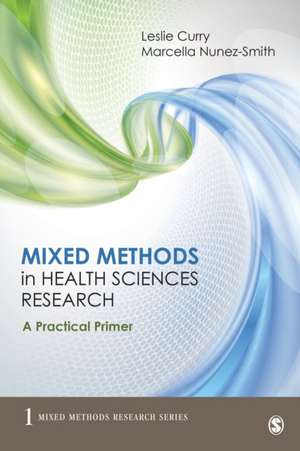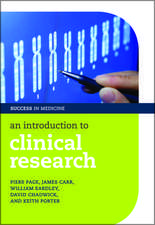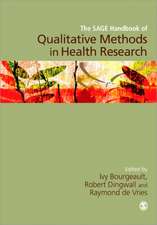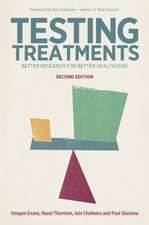Mixed Methods in Health Sciences Research: A Practical Primer: Mixed Methods Research Series, cartea 1
Autor Leslie A. Curry, Marcella Nunez-Smithen Limba Engleză Paperback – dec 2014
Preț: 457.19 lei
Preț vechi: 481.26 lei
-5% Nou
Puncte Express: 686
Preț estimativ în valută:
87.49€ • 90.79$ • 73.13£
87.49€ • 90.79$ • 73.13£
Carte tipărită la comandă
Livrare economică 17-31 martie
Livrare express 08-14 februarie pentru 62.03 lei
Preluare comenzi: 021 569.72.76
Specificații
ISBN-13: 9781483306773
ISBN-10: 1483306771
Pagini: 432
Ilustrații: illustrations
Dimensiuni: 152 x 229 x 20 mm
Greutate: 0.58 kg
Ediția:1
Editura: SAGE Publications
Colecția Sage Publications, Inc
Seria Mixed Methods Research Series
Locul publicării:Thousand Oaks, United States
ISBN-10: 1483306771
Pagini: 432
Ilustrații: illustrations
Dimensiuni: 152 x 229 x 20 mm
Greutate: 0.58 kg
Ediția:1
Editura: SAGE Publications
Colecția Sage Publications, Inc
Seria Mixed Methods Research Series
Locul publicării:Thousand Oaks, United States
Recenzii
“The content is highly applicable to real life research teams in the areas of clinical research, health services research, and implementation science, providing sound content and practical advice. The authors have synthesized and pull key concepts from a variety of sources to provide a concise resource.”
“Everything from the references, to the topics, checklists, conceptual graphic representations, and organizers, interviews, and resources, all contribute to the content and aid with understanding and/or application. ...It addresses specific MM research as it pertains to health sciences in a way that other texts just do not even attempt.”
“[This text is] a very pragmatic approach to mixed methods research; excellent resources, tables, and figures [are] provided, along with cases and examples of value to researchers and grant reviewers. Its relevance to practice, education, and research, as well as to potential policy implications, is a strong focus that would make this a valued textbook for any researcher!”
“The text is cutting edge. It leads the way with its focus on team dynamics. [The authors] succeed in making the book relevant and practical. They also articulate a number of key insights in the area of mixed methods that rarely get addressed, such as teams and conflict. Great read with a lot of good, practical information for mixed methods researchers at all levels. The practical approach of this text makes it an innovative and valuable resource.”
Given the increased use of mixed methods in the health sciences, this text is timely and unique in that it offers a discipline-specific focus that is both relevant and practical... an excellent and valuable resource for all health researchers using mixed methods, regardless of experience.
“Everything from the references, to the topics, checklists, conceptual graphic representations, and organizers, interviews, and resources, all contribute to the content and aid with understanding and/or application. ...It addresses specific MM research as it pertains to health sciences in a way that other texts just do not even attempt.”
“[This text is] a very pragmatic approach to mixed methods research; excellent resources, tables, and figures [are] provided, along with cases and examples of value to researchers and grant reviewers. Its relevance to practice, education, and research, as well as to potential policy implications, is a strong focus that would make this a valued textbook for any researcher!”
“The text is cutting edge. It leads the way with its focus on team dynamics. [The authors] succeed in making the book relevant and practical. They also articulate a number of key insights in the area of mixed methods that rarely get addressed, such as teams and conflict. Great read with a lot of good, practical information for mixed methods researchers at all levels. The practical approach of this text makes it an innovative and valuable resource.”
Given the increased use of mixed methods in the health sciences, this text is timely and unique in that it offers a discipline-specific focus that is both relevant and practical... an excellent and valuable resource for all health researchers using mixed methods, regardless of experience.
Cuprins
Part I: Mixed Methods 101
Chapter 1: Definition and Overview of Mixed Methods Designs
Definition and Characteristics of Mixed Methods Research
Key Factors in Mixed Methods Research Designs
Primary Mixed Methods Study Designs
Examples From Peer-Reviewed Published Literature
Chapter 2: Applications and Illustrations of Mixed Methods Health Sciences Research
Relevance of Mixed Methods Research in the Health Sciences
Illustrations From Mixed Methods Studies in the Health Sciences
Chapter 3: Determining the Appropriateness and Feasibility of Using Mixed Methods
Defining the Nature of the Research Question
Developing the Rationale and Aims for a Mixed Methods Study
Key Considerations at the Planning Stage of a Project to Determine Feasibility
Part II: Getting Mixed Methods Research Funded
Chapter 4: Writing a Scientifically Sound and Compelling Grant Proposal for a Mixed Methods Study
Before You Write
Trends in Funding for Mixed Methods Studies
Writing a Mixed Methods Proposal
Chapter 5: Examples of Funded Grant Applications Using Mixed Methods
Real-World Examples of National Institutes of Health Grant Applications
Tips From the Field
Chapter 6: Assessing Quality in Mixed Methods Studies
The Importance of Research Quality for Different Audiences
Common Standards of Quality in Qualitative and Quantitative Research
Additional Standards for Quality in Designing and Conducting Mixed Methods Studies
Examples of Threats to Quality in the Design and Conduct of Mixed Methods Studies
Part III: Designing and Implementing a Mixed Methods Study
Chapter 7: Sampling and Data Collection in Mixed Methods Studies
Principles of Sound Sampling
Principles of Sampling in Mixed Methods Studies
Practices of Sampling in Mixed Methods Studies
Approaches to Data Collection in Mixed Methods Studies
Chapter 8: Data Analysis and Integration in Mixed Methods Studies
Importance of Integration of Mixed Methods Data
Developing a Data Analysis Plan
Approaches to Integration in Data Collection and Analysis
Implementing Data Integration
Integration in Interpreting and Presenting Findings
Chapter 9: Managing Mixed Methods Teams
Why Think About Mixed Methods Teams?
Mixed Methods Teams as Representational Groups
Considerations and Guiding Principles for Managing Teams
Single Investigator Research
Chapter 10: Implementation Issues in Mixed Methods Research
Working With Human Research Protection Programs
Recommendations for Preparing a Strong Mixed Methods Application for Human Research Protection Program Review
Key Issues for Specific Mixed Methods Design Types
Implementation Challenges and Strategies From the Field
Part IV: Disseminating Findings
Chapter 11:Publishing Mixed Methods Studies in the Health Sciences
Challenges and Opportunities in Publishing Mixed Methods Research in the Health Sciences
Developing a Publication Strategy and Plan
Responding to Peer Reviews for Mixed Methods Studies
Example of Letter for Revision and Resubmission
Chapter 1: Definition and Overview of Mixed Methods Designs
Definition and Characteristics of Mixed Methods Research
Key Factors in Mixed Methods Research Designs
Primary Mixed Methods Study Designs
Examples From Peer-Reviewed Published Literature
Chapter 2: Applications and Illustrations of Mixed Methods Health Sciences Research
Relevance of Mixed Methods Research in the Health Sciences
Illustrations From Mixed Methods Studies in the Health Sciences
Chapter 3: Determining the Appropriateness and Feasibility of Using Mixed Methods
Defining the Nature of the Research Question
Developing the Rationale and Aims for a Mixed Methods Study
Key Considerations at the Planning Stage of a Project to Determine Feasibility
Part II: Getting Mixed Methods Research Funded
Chapter 4: Writing a Scientifically Sound and Compelling Grant Proposal for a Mixed Methods Study
Before You Write
Trends in Funding for Mixed Methods Studies
Writing a Mixed Methods Proposal
Chapter 5: Examples of Funded Grant Applications Using Mixed Methods
Real-World Examples of National Institutes of Health Grant Applications
Tips From the Field
Chapter 6: Assessing Quality in Mixed Methods Studies
The Importance of Research Quality for Different Audiences
Common Standards of Quality in Qualitative and Quantitative Research
Additional Standards for Quality in Designing and Conducting Mixed Methods Studies
Examples of Threats to Quality in the Design and Conduct of Mixed Methods Studies
Part III: Designing and Implementing a Mixed Methods Study
Chapter 7: Sampling and Data Collection in Mixed Methods Studies
Principles of Sound Sampling
Principles of Sampling in Mixed Methods Studies
Practices of Sampling in Mixed Methods Studies
Approaches to Data Collection in Mixed Methods Studies
Chapter 8: Data Analysis and Integration in Mixed Methods Studies
Importance of Integration of Mixed Methods Data
Developing a Data Analysis Plan
Approaches to Integration in Data Collection and Analysis
Implementing Data Integration
Integration in Interpreting and Presenting Findings
Chapter 9: Managing Mixed Methods Teams
Why Think About Mixed Methods Teams?
Mixed Methods Teams as Representational Groups
Considerations and Guiding Principles for Managing Teams
Single Investigator Research
Chapter 10: Implementation Issues in Mixed Methods Research
Working With Human Research Protection Programs
Recommendations for Preparing a Strong Mixed Methods Application for Human Research Protection Program Review
Key Issues for Specific Mixed Methods Design Types
Implementation Challenges and Strategies From the Field
Part IV: Disseminating Findings
Chapter 11:Publishing Mixed Methods Studies in the Health Sciences
Challenges and Opportunities in Publishing Mixed Methods Research in the Health Sciences
Developing a Publication Strategy and Plan
Responding to Peer Reviews for Mixed Methods Studies
Example of Letter for Revision and Resubmission
Descriere
Packed with illustrations from the health sciences literature, the book shows students how to design, conduct, review, and use mixed methods research findings. Throughout the book, real-world examples and insights from mixed methods researchers provide unique perspectives on every aspect of mixed methods research.























